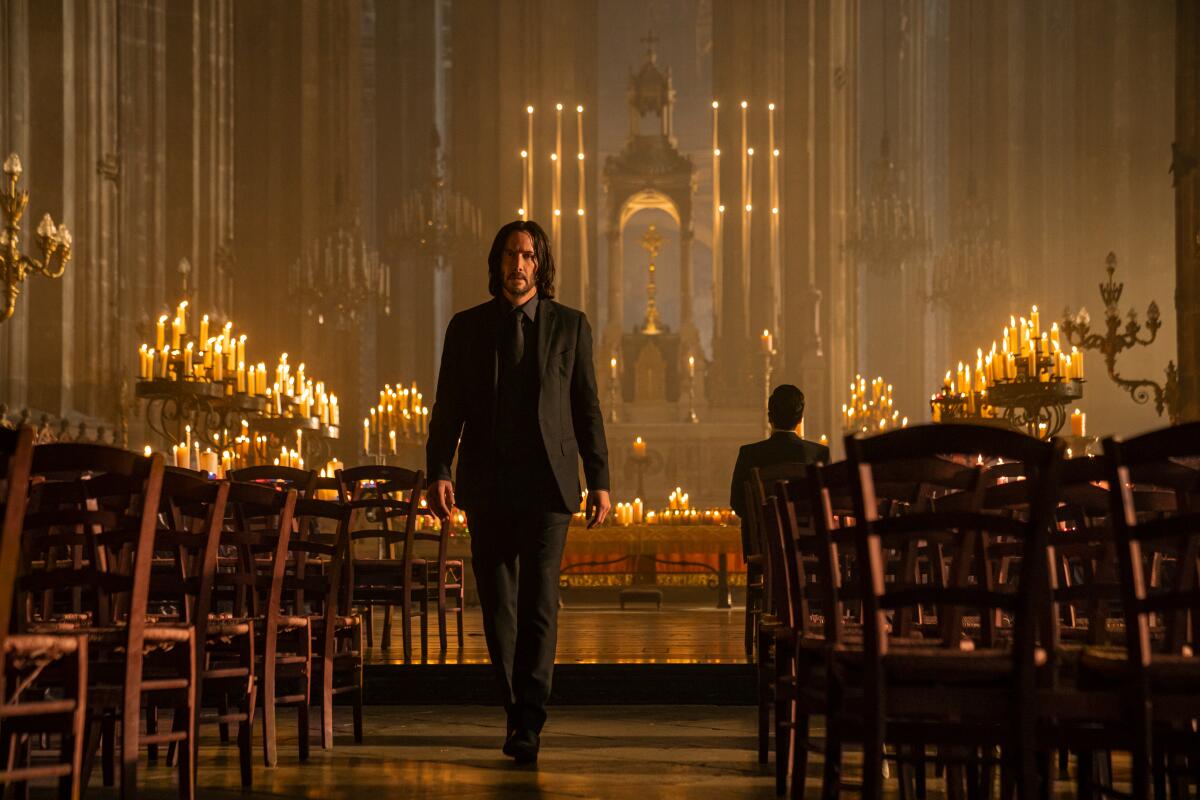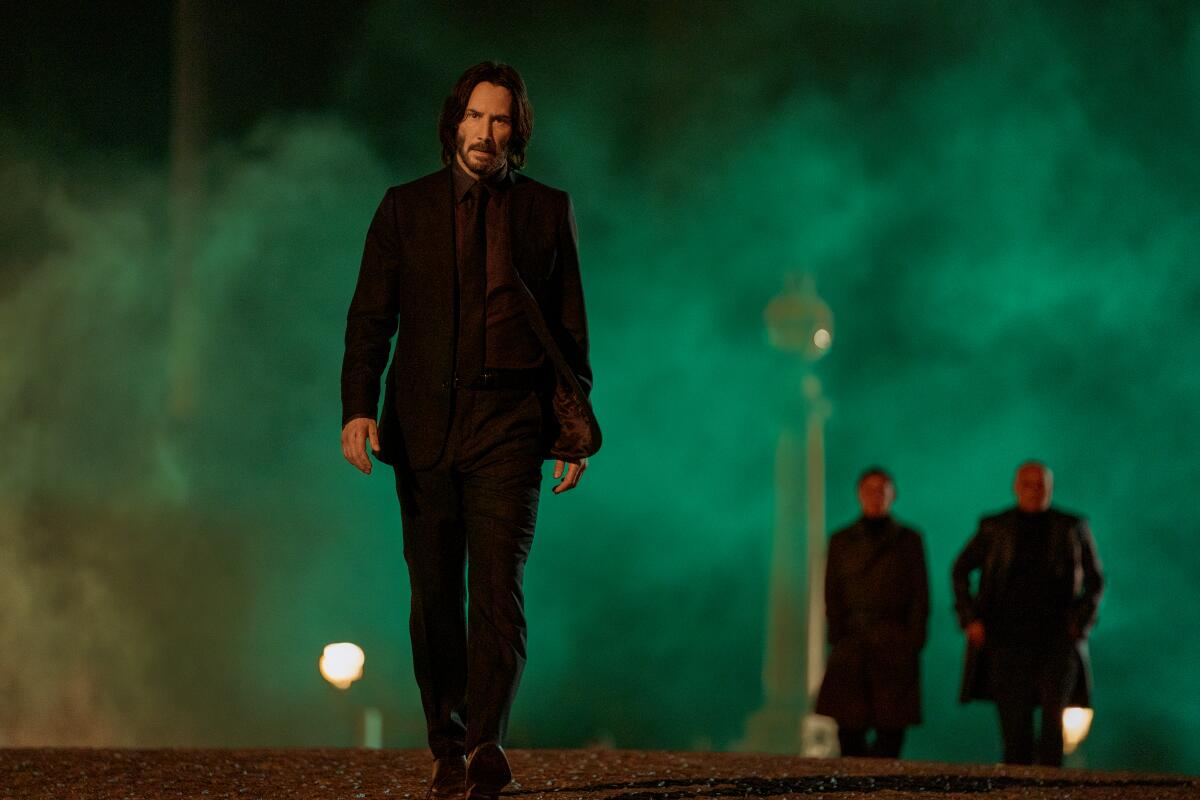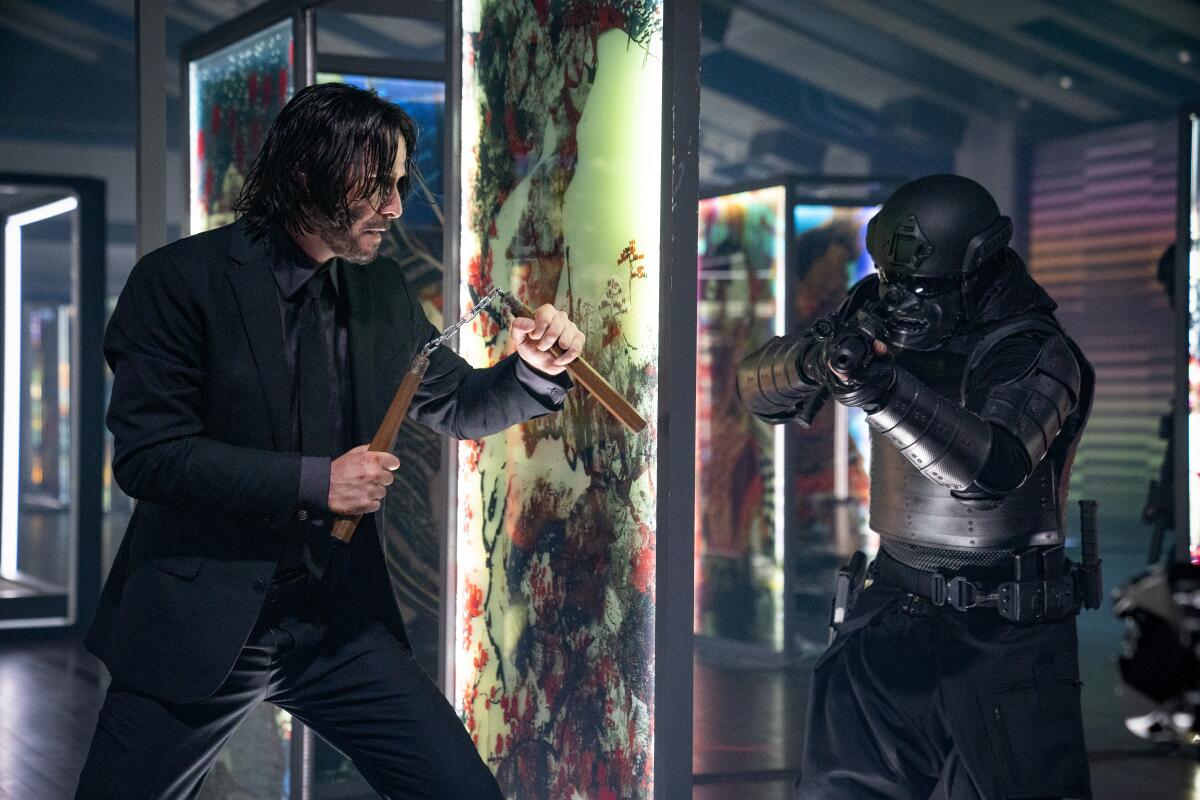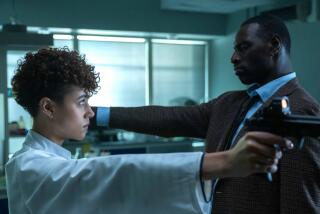Review: Something ‘Wick’-ed this way comes (again)

- Share via
Near the end of a recent press screening of “John Wick: Chapter 4,” a wave of groans and gasps swept through the audience, followed by a woman’s spontaneous cry of encouragement: “C’mon, Johnny, you got this!”
He does indeed, though for a moment you have to wonder. By this point, John Wick — the not-so-retired assassin played to melancholy perfection by Keanu Reeves — has spent roughly two hours falling from back-breaking heights and getting tossed about by fast-moving vehicles, and that’s only when he isn’t punching, kicking, stabbing and shooting his way through phalanxes of armed assailants. Now, like a beleaguered video-game avatar staggering to the big-bang finish, he faces an uphill climb and a series of smackdowns to make both Sisyphus and Wile E. Coyote grunt in sympathy.
For your safety
The Times is committed to reviewing theatrical film releases during the COVID-19 pandemic. Because moviegoing carries risks during this time, we remind readers to follow health and safety guidelines as outlined by the CDC and local health officials.
Really, the only sane response is to laugh, not that the deathly serious John Wick would be so inclined even if he could muster the energy. He’s exhausted, and “John Wick: Chapter 4,” for good and for ill, is exhausting. Directed, like its three predecessors, by the stuntman turned filmmaker Chad Stahelski, it’s the saga’s latest and longest entry (169 minutes), and while future chapters and offshoots may await, this one presents itself with the self-admiring grandiosity of a closing statement.
Barely five minutes in, Stahelski and editor Nathan Orloff blatantly reference one of the most famous cuts in film history, a puckish mashup of Laurence Fishburne and “Lawrence of Arabia.” This is John Wick gone global; it’s “The Wick Ultimatum.” Leaping from sun-scorched Moroccan deserts to neon-lit Japanese courtyards to rain-drenched German outdoor nightclub, the movie unleashes hell in grand, globe-trotting style. Even by series standards, it’s an astonishingly staged and sustained panorama of violence, much of it mediated (and attenuated) by the usual inventive weaponry and bulletproof menswear, and meted out by international action stars including Donnie Yen and Hiroyuki Sanada.
Enjoyable as it is, all this maximalist showmanship can feel antithetical to the first film’s sleek, witty economy. A modestly scaled 2014 hit, the original “John Wick” turned on an ingeniously simple premise — grieving ex-hit man versus the Russian mobsters who murdered his dog — and moved with brooding finesse from one beautifully staged action sequence to the next. But while it worked nicely as a stand-alone revenge flick, it also ushered us into an assassins’ underworld so densely and stylishly imagined that future visits seemed inevitable.

And so they were. I don’t remember much of what happened in “John Wick: Chapter 2” and “John Wick: Chapter 3 — Parabellum,” and I don’t have time right now to catch up on Wickipedia. But amid all the arcana and arms deals, the enemies and excommunications, the series had a few key sustaining constants. There was Reeves, of course, a perfect killer for a grimly imperfect world. There was also the gleaming precision of Stahelski’s filmmaking, rooted in the unfashionable belief that the camera should savor, rather than compete with, the spectacle of bodies in violent motion.
Happily, that belief is more than upheld in “Chapter 4,” whose commitment to compositional elegance (courtesy of the returning cinematographer Dan Laustsen) is as inviolable as an assassin’s blood oath. Given the inscrutably murky digital melees that pass for so much Hollywood action filmmaking these days, a fight scene in which you can actually see what the hell’s going on is nothing to take for granted.
It can also justify a lot — not all, but a lot — of the extraneous world-building hooey in Shay Hatten and Michael Finch’s script. As the saga recommences, Wick has declared war on the High Table, which is not a club for standing-desk enthusiasts but rather an elite, all-powerful assassins’ council. Wick’s actions incur the wrath of the Marquis (Bill Skarsgard), the callow and sadistic Table head who, like a Rick Steves guide in a three-piece suit, prefers to conduct his business against Paris’ most famous landmarks.
The Marquis has powerful weapons at his disposal, none more formidable than Caine (Yen), a latter-day Zatoichi who, with the help of a sword, a Kevlar suit and some hilariously deployed motion sensors, turns his lack of sight into a lethal attribute. A figure of spidery elegance, Caine is, like Wick, a reluctant killer, pressed into service against his will and better judgment. That places him in direct conflict with Wick’s unfailingly loyal ally Shimazu (Sanada, soulful as ever), who owns the shimmering Osaka branch of the Continental, that luxury hotel chain where murderers are welcome but murder itself is as verboten as a dress-code violation.

Needless to say, that rule is about to be thrown out the window, along with several efficiently dispatched corpses. Skulking in the shadows of all this mayhem is a shifty-eyed tracker (Shamier Anderson) whose allegiance would be more of a mystery if he didn’t come equipped with a faithful Belgian Malinois. Whether cuddly or lethal or both, canine companions continue to occupy a privileged place of honor, commanding an allegiance more powerful than all the codes and bounties in the Wickiverse. You know a killer is redeemable if he has a dog — or, in Shimazu’s case, a daughter (Rina Sawayama), whom he’s raised to be as lethal as her doubtless many enemies to come.
The meticulous foreshadowing of future conflicts feels appropriate to a world built, destroyed and rebuilt by endless cycles of killing; conveniently enough, it also lays the groundwork for future “John Wick” spinoffs. If any do materialize, I hope they’ll be as lustrous-looking as this one, though also a bit more disciplined. There are moments when the pummeling virtuosity of “Chapter 4” sputters and stalls, when its entrancing beauty takes an unproductive, ponderous turn. It’s telling that one early action highlight finds Wick and Caine waging a battle of wits and senses (and swords and nunchaku) against an elaborate display of Japanese paintings. Look, the movie says, and see how the destruction of an art gallery can become a work of art unto itself.
That self-regard is justifiable, though only up to a point. After a while, I lost count of how many scenes take place in chambers and grottos illuminated, to an almost oppressive degree, by candlelight. (The effect is suitably eerie, though nowhere near as scary as the wax budget.) I also lost count of the various other baddies the movie tries to squeeze into the mix, including a fat-suited Scott Adkins as an especially hard-to-kill cardsharp. At this point, minor villains can only be an encumbrance. Best to keep them as nameless as the various thugs that Wick takes down in the movie’s deliriously drawn-out Paris climax, whether during a jaw-dropping God’s-eye-view tracking shot, with fiery carnage spilling from room to room, or an Arc de Triomphe stopover that brings new meaning to the term “hit-and-run.”
Through it all, Reeves somehow barrels through the picture with equal parts rampaging force and Zen-like cool. Never one to upstage his fellow actors, he succeeds, as few movie stars could, at both drawing and deflecting the camera’s attention. Wick’s gun-fu is peerless, his endurance herculean, his weariness palpable. But through circumstances that none could have foreseen, the movie’s strongest surge of emotion doesn’t belong to him. That honor understandably goes to Lance Reddick, here making his fourth and final appearance as Charon, the faithful Manhattan concierge and trusted ally of Wick’s old associate Winston (the invaluable Ian McShane).
Reddick died last week at the age of 60, a tragedy that casts an inevitable pall over his impeccably grave performance and over the movie as a whole. For the most part, Charon, whose name has never felt more gloomily appropriate, stood at an elegant, watchful remove from the violence of Wick’s world; he was a fixer and a facilitator, not a participant. But Reddick, with his bone-dry wit and his eyes that seemed to miss nothing, never seemed detached or checked out; he could give even chilly efficiency a human pulse. In a series of movies that trafficked so beautifully and brutally in death, here was an actor who flooded the image with life.
‘John Wick: Chapter 4’
Rating: R, for pervasive strong violence and some language
Running time: 2 hours, 49 minutes
Playing: Starts March 24 in general release
More to Read
Only good movies
Get the Indie Focus newsletter, Mark Olsen's weekly guide to the world of cinema.
You may occasionally receive promotional content from the Los Angeles Times.











